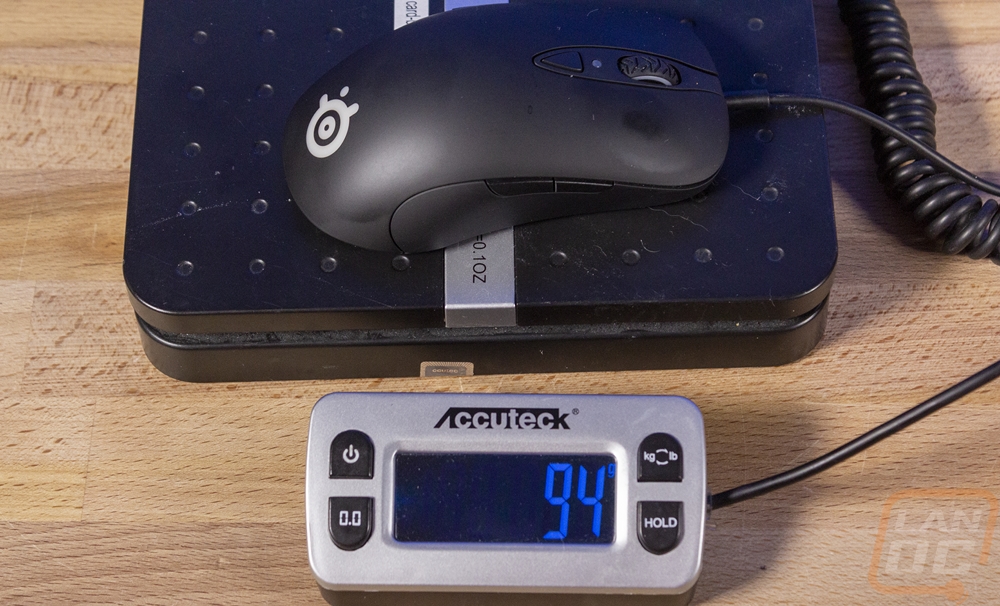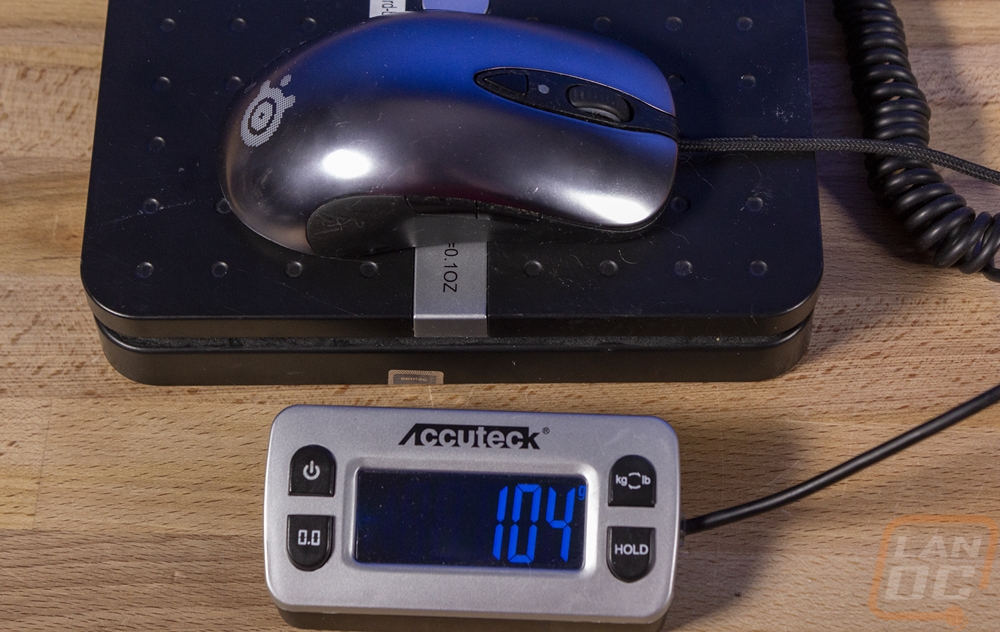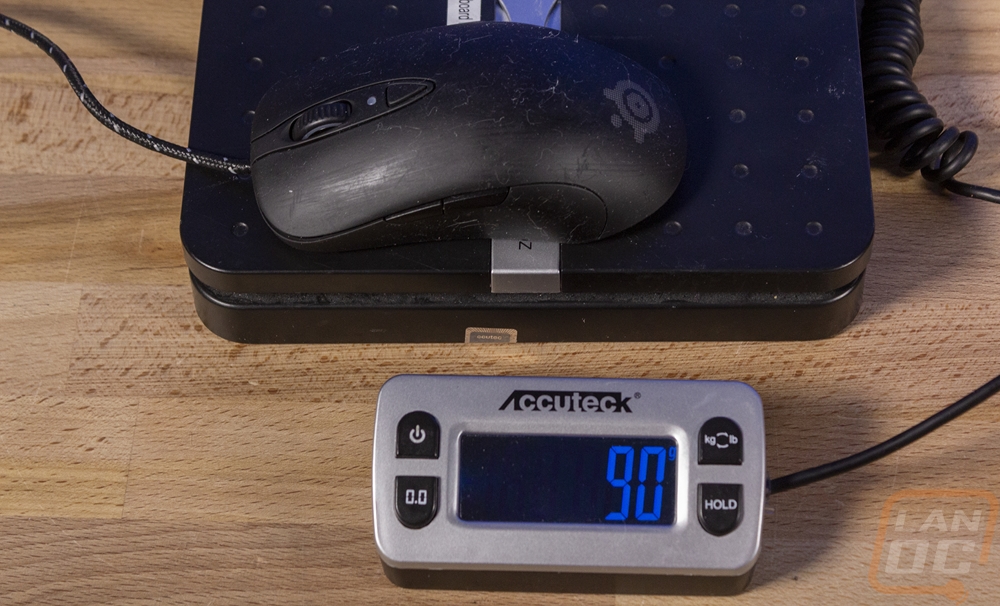Photos and Features
It's not very often that you can open up a box and see the exact same thing you have seen countless times over 10 years and still be excited. That is what happened when I pulled the Sensei Ten out. What I found in the box looked exactly like the Sensei RAW and all of the other Sensei and Xai mice. There were a few differences, but at least when it comes to the shape it looks like SteelSeries is using the same molds. What that means is the Sensei Ten is an ambidextrous shape coming in at 126mm long. It is 63mm wide at the front and 68mm wide at the back of the mouse. Then for height it is 21mm at the front and 39mm at its peak. That peak falls up under your knuckles and helps let your fingers ramp down across the triggers. As I mentioned before, this is like the Sensei RAW or the Xai, not like the original Sensei which had a unique metallic finish so the Sensei Ten does have a rubberized finish on it.




The top-down look on the Sensei Ten lets you better see how the shape gets smaller towards the front. The measurements don’t really account for what I like to call the coke bottle shape though. You can see how the sides have a slight overhang on the front but none at the rear. This is what a lot of mice have a hard time including. Some people pick up their mice when gaming, myself included, and to do that you need to have a grip that allows for that. A lot of mice just toss on a rubber or in the case of the Sensei 310 a silicone grip and call it good. But designing it into the shape is a lot more effective and then you also don’t have to worry about the grip being greasy and not working. Rubber grips also often break down, this is something that SteelSeries of all people should know about because they have leaned heavily on grips for their Rival mice and they are notorious for wearing out or failing. This ended up being why I stopped using the Sensei 310 as well, the silicone grip felt fine in my initial testing, but later got greasy. Now the overhang can also be too much, getting just enough to hold on to the mouse but not enough to be in the way is hard, but the Sensei shape does just that.

The side views of the Sensei Ten show the ambidextrous shape really well. Both sides are exactly the same. They both have that coke bottle shape and they both have two thumb buttons. That means lefties aren’t left without side buttons and both uses can use both sides if you use your ring finger though I don’t because it takes away from my grip. The sides don’t have any add on rubber grips though they do have the same rubberized finish that the entire mouse has. You can see that the casing is split though from the top of the mouse and the two sides with that gap growing larger near the front of the triggers to allow room for them to move. The one difference between the two sides is the tiny symbol on the left side. I actually thought it might be the Fnatic logo but they no longer work with them after Fnatic picked up their own peripherals brand. It’s actually the symbol 天 which means Sky/heavens/heavenly in Chinese, Korean, and Japanese. This shows that the Sensei Ten name has a double meaning as well which is really cool, it is ten years of the shape but also the Sensei Heaven.


The back of the Sensei Ten has the same SteelSeries logo that is always found on their mice. It is white when not powered on but the transparent white glows in full RGB when powered up. When the Sensei first launched I said that SteelSeries jumped the shark by adding RGB lighting after they made fun of other mice for going that route, but I have to admit that at least they never went any crazier than what they originally added. There aren’t any underglows, just the logo which is under your hand and the scroll wheel.

Unlike the Sensei 310, the triggers are still part of the top casing which is a change that I would be okay with them changing on the original Sensei design. But this is also an area where we can finally talk about what is different with the Ten compared to past models and frankly a lot in this area changed. The button behind the scroll wheel and the LED indicator light are still there but I did notice that it works differently. In the past this would switch between two CPIs and the LED would let you know which you were on by being on or off. Now they have switched to FIVE different settings and to show which you are on you have to look at how fast the LED flashes. I hate it lol. Even with just two settings I would almost always program them both to be the same, but why make it so hard to see which you are on. An RGB LED would have done a much better job at least. In front of that the scroll wheel has changed. It at least has a new grip on it with hockey stick like groves cut in it where the old design had horizontal cuts. As an avid Sensei user, I really hope the scroll wheel itself was changed as well. I had multiple fail on me over the years. I had a Xai just completely die on me (serial number 34 RIP), one Sensei die, one with a trigger that failed, but the scroll wheel issues happened more than any of those. Just google Sensei Scroll Wheel Issues to see what I mean.
Beyond that you can visually see that they have changed where the cord goes into the mouse. I’m guessing that cords had a few issues getting abused right at the mouse because the old design didn’t have a support where it goes into the mouse. It's great to see small changes like this that are clearly implemented to fix reliability issues. Then, of course, SteelSeries has put new switches in for the triggers as well. They are branding them under the SteelSeries name and they are rated for 60 million clicks, 10 million more than the 50 million click Omron used in the Sensei 310. I’m not a fan of the branding, just like they have done with their sensors but I am interested to see how they perform.


Flipping the Sensei Ten over there are a few things I want to highlight. I mentioned earlier this looked like a Sensei RAW. Flipping it over to see the semi-transparent bottom didn’t help with that. The RAW had the same thing where it dropped the original Sensei’s LED screen for a simpler design. The glider shape and size are the same as well, at least for the main three on the outside edge which is all the older Sensei’s had. They did add a glider around the sensor on the Ten however which I really like seeing. This helps keep the sensor distance the same when you press down on your mouse. The three original gliders while having the same footprint are a little flatter than the old nice which used to have more of a crown to them. This should give more contact surface right from the start.
As for the sensor, the old ADNS 9500 that almost every mouse at that time used is finally gone. It wasn’t bad for a laser sensor, but it did have acceleration. After the Sensei came out people started to really push for “flawless” sensors which they did fix later in the Sensei 310. But they didn’t stick with the Truemove 3 sensor either, the Ten has a new sensor they are calling the TrueMove Pro. It goes up to 18,000 CPI which no one really needs, but the important number is in the IPS which is inches per second that the sensor can read. They are saying the new sensor has an IPS of 450. The Sensei 310 had an IPS of 350 with its 3360 based Truemove 3 sensor. I haven’t pulled the Sensei Ten apart, but I suspect with the 50 CPI adjustment increments and the higher IPS that this might be a 3389 based sensor with SteelSeries specific tune that gets it from 400 IPS to 450, though SteelSeries also points out in the specifications that it reaches 450 IPS on their mouse pads specifically. Overall this is a huge improvement over the old sensor of the Sensei and a decent step up from the Sensei 310 as well.



When the original Sensei came out everyone wanted a sleeved cord and hated on the less protected rubber cords. Years later things have changed some. Some people don’t care at all about sleeving where for some enthusiasts it is the end all be all. The one thing they both have in common though is the cord being extremely flexible which is something the Sensei 310 did really well. Having just reviewed the Cooler Master M710 with its shoestring like sleeving, I can completely see why people would want that. Well the Sensei Ten has neither. Its cord is rubber and is better than the sleeved Sensei cord as far as flexibility, that thing was stiff! I wouldn’t even call this stiff at all, it's actually good, just as long as you don’t compare it with the Sensei 310 or the M710. As for length you get a lot, 6.75 feet in total length with a SteelSeries branded USB plug at the end. They did also toss a tag on the cord to remind you to download the software from their website.



Now that I have given the Sensei Ten a full look I thought it would be interesting to dig out a few of the original mice though now that I’m writing this I regret not getting out one of the Xai’s and maybe our ultra-rare gold Sensei. But I did get the original Sensei and the Sensei RAW which are the two most popular variations. The idea was to show that the same and everything is the same and you can see the improvements like the cord support where the cord goes in the mouse on the Ten. The bottom view shows how the original Sensei had a black base and that built-in screen. I actually really liked being able to change settings and set my DPI/CPI without any software, but it did add a lot to the weight and cost. That is where the RAW came in, they went back to the rubberized finish of the Xai, dropped the screen, and added a little flair to the sleeved cable as well as a transparent base.



The RAW was everything you need and nothing you didn’t. I included it in my photos here because I also wanted to show the downside to the rubberized finish that SteelSeries is still using. Now they may have changed the formula, but there is a reason the Sensei 310 didn’t have it. Razer and Logitech have also moved away from the finish as well. The fact is, the rubberized finish isn’t going to last forever. For some people who rub their mouse a lot or have sandpaper for hands, they may rub through it. In my case, it lasted just fine. In fact this wasn’t even that old of a RAW, it was a replacement. I had this in my LAN bag where I only use it a few times a year at LAN events. One event it was fine and the next it pulled it out and it was a sticky mess. The rubber finally just broke down. Seriously, as nasty as it looks. This is after I tried to clean it, it is so sticky it just collects any fibers in the cloth or air. Oils in your hands obviously play a role, but I have had other devices like the Sapphire HD-Edge do the same thing when it was hardly ever touched. What I’m saying, is while I’m happy the Sensei Ten is mostly unchanged, I do think they should really consider none rubberized models as well. The mouse shape doesn’t need it for grip and given improvements in switch, scroll wheel, and cord durability a Sensei Ten with a plastic or even painted finish will most likely last longer in the end.

Don’t worry I didn’t forget to weigh the Sensei Ten as well. I put all three Sensei’s on the scale just to show the progression and some of you might be surprised by the results. Now the original Sensei with its screen on the bottom comes in at 104 grams. Then you have the Sensei Ten at 94 and the RAW lower than that at 90 grams. Yeah, the new mouse isn’t actually less weight than the Sensei RAW which might be a surprise if you have looked at SteelSeries marketing which talks about the 10% less weight. They are comparing it with the original Sensei. They didn’t change the internal structure of the Sensei Ten which is one area where a lot of weight can be lost. Look at the Logitech G Pro Wireless which comes in at 80 grams and it is wireless, they did that with a new structure inside. The MM710 that I just reviewed came in at 56 grams and the Sensei 310 was even less than the Ten at 92.5 grams which includes the heavy silicone grips on each side which I’ve heard are 8 or 9 grams themselves. The Ten’s weight went up over the RAW with additions like the cord protector and the extra glider around the sensor. So if you are looking for a lightweight mouse this isn’t really it. I wouldn’t call it heavy as well though, but hopefully SteelSeries considers continuing to evolve the Sensei by lowering the weight without making shape changes as they did with the 310. Especially when they have competition bringing out mice like the Razer Viper at 69 grams and the G Pro Wireless at 80 while being wireless. It’s clear that the enthusiast market does like lower weight mice and the other big names have proven that it can be done without drilling holes with innovations in the internal structure and materials.





